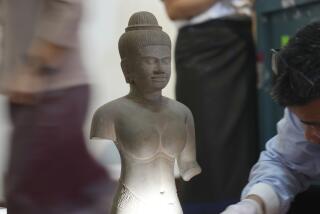A Living Record of an Ancient Art : Cambodia: A master dancer performs for a video that will help preserve a court tradition.
When she was 4, Somaly Hay’s parents in Cambodia sent her to the Emperor’s palace to learn the techniques of court dance from the masters.
As she got older, the dance masters picked her to perform in choice roles at the royal palace.
But when the Khmer Rouge swept through her native land in 1975, killing the educated and the artistic, many practitioners of her ancient art were wiped out. Among the few who survive are those who, like Hay, fled to the United States.
And so, to preserve the tradition she was taught in a faraway land in a vanished time, Hay danced for the television cameras Wednesday at Cal State Northridge, making a videotape so that future generations of Cambodians will thus be able to see what a real court dancer looked like, before the revolution.
Hay, now 32, is considered one of fewer than a dozen Cambodian master dancers in the United States.
Hay and three other master dancers, along with two young apprentices, performed their art in the school’s Instructional Media Center for the video made by Sam-Ang Sam, a Khmer musician and professor of ethnomusicology at the University of Washington, Seattle.
“The main concern in the United States is that there is a shortage of professional master artists” in this country, Sam said. “There aren’t enough experienced people” to teach new generations of Cambodian descent in the United States “the pure form of the art,” he said.
Hay and the five dancers glided gracefully across the studio, moving their arms in graceful angular motions and shuffling their feet in perfect time.
Adorned with two-foot-high brass crowns and costumes of fiery red, emerald green and magenta, the women gazed in their partners’ almond eyes. They circled each other and separated to form a straight line, delicately stamping their bare feet, the toes decorated with rings.
They danced the “Tep Monorom,” representing the gods and goddesses of Cambodian folklore, which was traditionally used to entertain dignitaries at the palace.
The project was funded by a $28,000 grant from the Folk Arts Program of the National Endowment of the Arts.
Hay escaped from Cambodia in 1981 after surviving the years of Khmer Rouge rule by pretending that she was the daughter of poor food vendors, not the middle-class parents she actually had.
“You couldn’t allow them to know you’re a dancer or you’d get killed,” Hay said.
The majority of teachers from the Royal Conservatory were eliminated, said David Roche, director of the Local Cultures Program, an Oakland-based organization that sponsors ethnic art. Roche was on the panel that selected Sam’s video for funding by the National Endowment for the Arts.
“A panel of 13 individuals who are knowledgeable in the area of folk tradition thought this was a deserving project,” said Bess Hawes, director of the endowment’s Folk Arts Program.
“The idea was to bring together the very best dancers and musicians who made it to this country, and record the best of their art form to use as a library of performances . . . a living record of things they do, so the young people can learn and the older people will be comforted because the tradition is preserved.”
Today, Hay lives in Waterford, Conn., dances professionally and teaches in schools through a program sponsored by the Connecticut Commission of the Arts to bring masters of the arts into classrooms, she said.
When complete this summer, the video will be available through the Khmer Studies Institute based in Newington, Conn., which intends to distribute it to Cambodian groups across the country, educational institutions and libraries.
More to Read
Sign up for Essential California
The most important California stories and recommendations in your inbox every morning.
You may occasionally receive promotional content from the Los Angeles Times.










